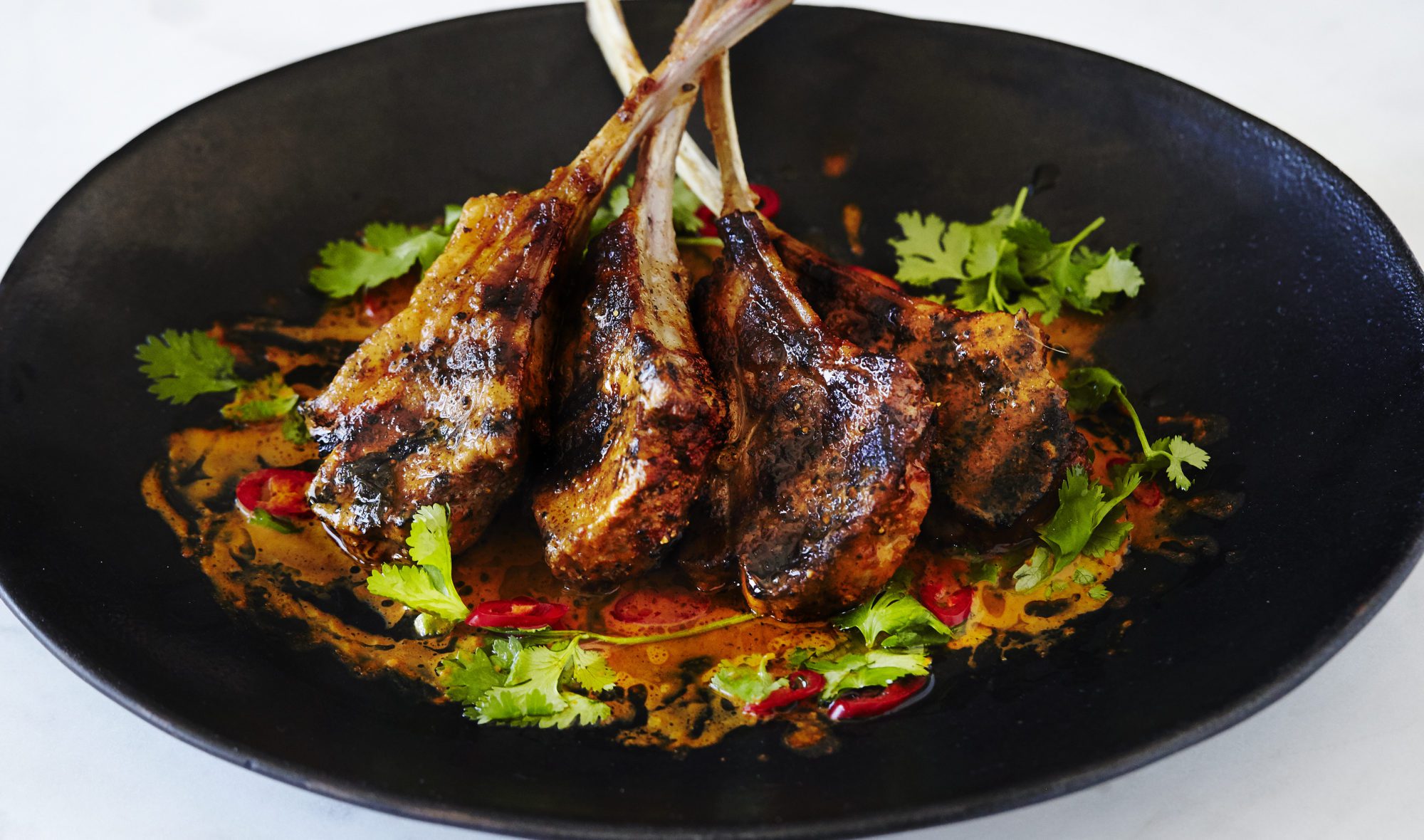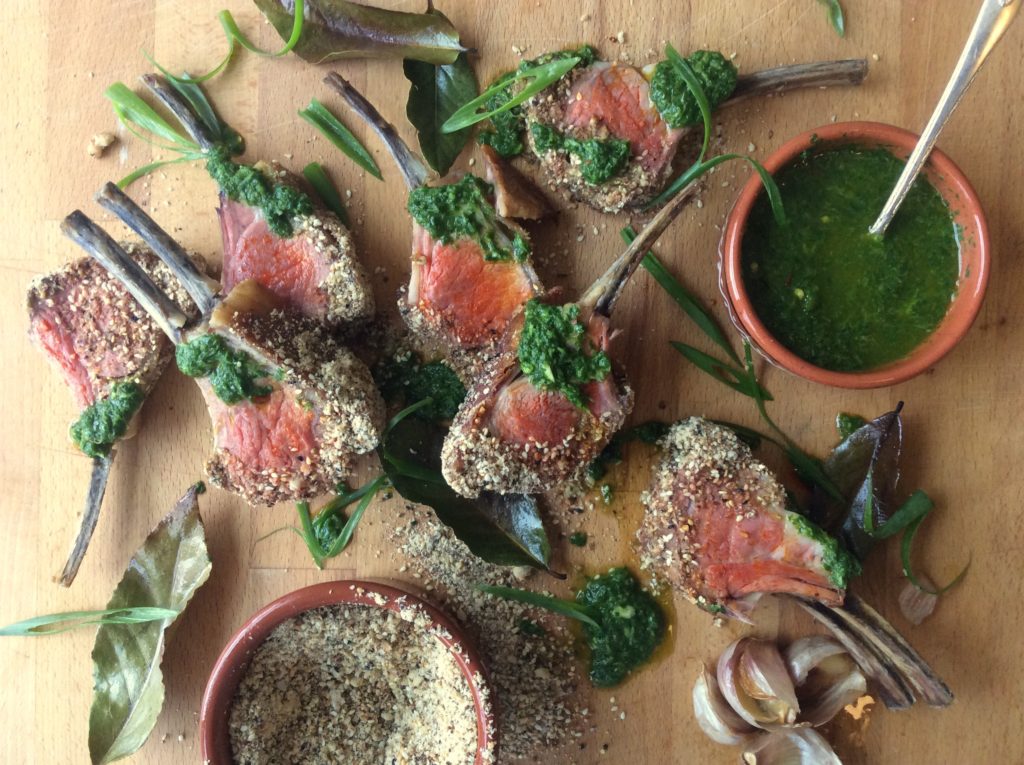
💥 Lowest price possible: on the Nutrition Coach Starter Package. Limited # left.

Lamb meat comes from sheep less than a year old. This flavorful, protein-dense meat is a good source of iron and vitamin B12. It lends itself to both fast and slow cooking methods, depending on the cut. Rack of lamb, lamb chops (rib or loin), and lamb burgers are just a few of the many possibilities this meat offers. Lamb is commonly imported from Australia and New Zealand, but lamb is also produced in the US and Canada. Look for lamb in your grocery store, farmers’ market, or local butcher shop.
Lamb refers to the meat from a sheep less than a year old. Common cuts include the rack, rib chops (cut from the rack), loin, leg, and shank. Ground lamb is also fairly easy to find: it can be used in burgers, meatloaf, or “kofta” (a recipe popular in many middle eastern countries).
Other parts of the animal can also be enjoyed, though some are less common in the US: these include brain, tongue, neck, heart, and more.
Lamb is often imported from Australia and New Zealand. Relatively small amounts of domestic lamb are produced. In the US, most domestic lamb comes from Texas, California, and Colorado; in Canada domestic lamb comes mostly from Ontario and Quebec.
When raw, lamb coloring can range from soft pink to deep red. The color should look clean and bright. Depending on the cut, you can usually see some white fat marbling throughout or around the meat.
Once cooked, lamb is usually a rich brown-red color. Like beef, pinkness indicates rawness; if you are cooking lamb to medium-rare, you’ll want to see some pink and red color within the middle of the meat.
When choosing lamb, you’ll notice that cuts can range from very large (whole roasts like legs or racks) to quite petite (small rib chops, riblets, or loin chops). Got more time to cook and feeding a crowd? You might go with a larger, whole roast. Want to get your feet wet with some quick-cooking, individual portions? Try individual rib-chops or loin chops.
One broiled loin chop (46g) contains about 99 calories, 13.80g of protein, and 4.48g of fat.
Lamb also offers iron, vitamin B12, niacin, and riboflavin.
Keep in mind that nutritional content will depend on what the animal ate. For example, grass-fed lamb will offer a beneficial boost of omega-3 fatty acids.
Look for lamb in your grocery store, farmers’ market, or local butcher shop.
Whether you choose domestic lamb or imported lamb is up to you. Different countries typically raise different breeds of sheep, and have different methods for raising and feeding their sheep. These differences will influence texture and taste. You may choose to try a few different cuts from a few different places in order to choose your favorite. And when in doubt, ask your butcher!
Note: lamb flavor can range from mild to slightly ‘gamey’. Some people adore that savory, wild flavor, but for others it’s less palatable. If you’re new to lamb, you might stick to conventional cuts (e.g. loin or rib chops) and seek out American lamb, which tends to have a milder flavor than New Zealand lamb.
Here are some other things to consider when selecting meat:
For more information on lamb cuts, grades, and more, visit the USDA website.
Lamb should be stored in the refrigerator or freezer and cooked before its expiry date. If you’ve purchased meat from a butcher and it’s wrapped in paper but not thoroughly sealed you may want to put the package in a sealable freezer bag to keep it fresh.
If you won’t be eating the meat within a couple days (or before the expiry date), you can freeze it to extend its lifespan. Generally, meat in the freezer will be good for a couple of months. Make sure it is wrapped in a tightly sealed heavy-duty freezer bag to avoid freezer burn.
Once cooked, lamb will last a few days in a sealed container in the fridge.
Remember that frozen meat, once defrosted, cannot be refrozen.
Preparation varies widely by cut. Tender, quick cooking cuts of lamb such as rib chops or loin chops can be grilled, broiled, or pan-fried.
A rack of lamb will need to be roasted in the oven at a fairly high heat: a roast will take about 20-25 minutes at 475 degrees Fahrenheit.
Tougher, thicker cuts such as lamb legs will need to be slow-cooked. Braising is a good method for this: sear the lamb in a large, oven-friendly pot. Then cover with liquid (water, stock, wine, or a combination), and transfer to the oven. Cook at 325 degrees Fahrenheit for approximately 4-5 hours, depending on the size of the cut.
When cooking, keep in mind the USDA safety guidelines. The USDA recommends cooking ground lamb (such as burgers) to a minimum internal temperature of 160 degrees Fahrenheit as measured on a food thermometer.
Whole cuts (such as chops or roasts) may be cooked to your preference. The USDA recommends cooking lamb to 145 degrees Fahrenheit for considered medium rare or 160 degrees Fahrenheit for medium. As with steak, you can cook lamb to well done (170 degrees Fahrenheit) but this could turn tender cuts tough and chewy.
Lamb is known for its rich, savory flavor. It holds up well with bold spices and herbs including mustard, rosemary, cumin, and mint.

Want to "wow" your friends and family? Give this recipe a try! The flavor combinations are sure to impress and leave everyone wanting more.
Prep Time: 25 minutes Cook Time: 15 minutes Yield: 4 servings
Lamb Directions:
Preheat a grill pan or large heavy bottomed skillet to medium-high heat. Season lamb well on all sides with salt. Once the pan is smoking hot, add the garlic cloves and bay leaves in one corner. Add the lamb and sear evenly on each side, flipping as you go (about 3 minutes on each side.) When the chops are charred and nicely colored, remove from heat and let rest for a minute. Cut each rack in half.
Dukkah Directions:
Using a spice grinder, grind the hazelnuts and coriander seeds into a coarse meal. Transfer to a small bowl and add the sesame seeds to the grinder. Pulse a few times to break up the seeds. Add the ground sesame seeds to the bowl with the nuts and coriander. Season with salt, and set aside.
Salsa Directions:
Combine ingredients in a blender and pulse to combine until uniform in texture but still a little chunky (you will likely need to use a rubber spatula to scrape down the sides once or twice).
Transfer to a small bowl.
Assembly Directions:
Crust each chop generously with the dukkah, and place on a serving platter. Spoon some salsa over each piece.
Serve immediately. Enjoy!
Precision Nutrition’s Encyclopedia of Food expands every single month as we highlight new foods and showcase beautiful food photography. If you’d like to stay up to date, simply click this link. From there, we’ll send you a FREE copy of our recipe book. We’ll also let you know when new and delicious foods are added to the site.
Lamb meat comes from sheep less than a year old. This flavorful, protein-dense meat is a good source of iron and vitamin B12. It lends itself to both fast and slow cooking methods, depending on the cut. Rack of lamb, lamb chops (rib or loin), and lamb burgers are just a few of the many possibilities this meat offers. Lamb is commonly imported from Australia and New Zealand, but lamb is also produced in the US and Canada. Look for lamb in your grocery store, farmers’ market, or local butcher shop.